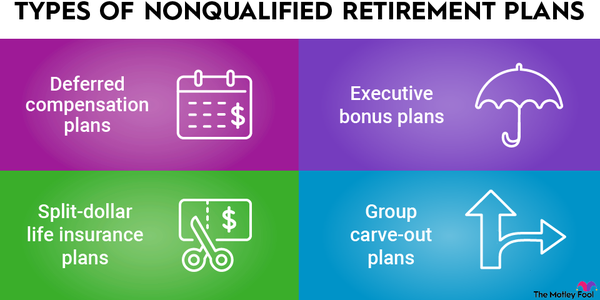An employer-sponsored retirement plan is a workplace benefit offered by some companies to help provide workers with income in retirement. Employer-sponsored plans take different forms, but they fit primarily into two categories:
- Defined benefit plans, which promise workers a specific amount of retirement income.
- Defined contribution plans, which don’t guarantee any retirement income but instead allow workers to save for retirement, often with some employer assistance.
Employer-sponsored retirement plans -- and especially defined contribution plans -- are very common. In March 2024, the Bureau of Labor Statistics reported that 78% of full-time private-sector workers had access to a defined-contribution retirement plan.
However, there are pros and cons to consider before using a workplace retirement plan to save for your later years.

Types
Types of employer-sponsored retirement plans
Employers determine the type of retirement savings plan they want to offer. Workers usually, but not always, can opt in or out. Some of the most common types of employer-sponsored retirement plans include the following:
Qualified retirement plans
Qualified retirement plans
Qualified retirement plans are tax-advantaged retirement plans subject to the 1974 Employee Retirement Income Security Act (ERISA) rules, as well as IRS guidelines. ERISA requirements are extensive. Plans are subject to minimum participation requirements, annual contribution limits, and vesting requirements.
Employers and employees can contribute to them with pre-tax dollars, though many plans also have a post-tax Roth option. Employers are subject to reporting, disclosure, and funding rules.
Non-qualified retirement plans
Non-qualified retirement plans
Non-qualified retirement plans are employer-sponsored retirement plans that do not have to meet ERISA guidelines for tax-qualified status. These plans are often provided to highly compensated employees as a benefit.
Non-qualified plans aren’t subject to annual contribution limits, and there are far fewer reporting requirements. Often, they're funded informally, and employers can't deduct their contributions until the employee actually receives the benefit. Employers can limit participation to select employees.
Defined benefit plan
Defined benefit plan
A defined benefit plan is an employer-sponsored retirement plan that guarantees an employee will receive a specified benefit in retirement. Also called pension plans, defined benefit plans require employers to assume the investment risk and responsibility for funding the plan.
The amount of money an employee receives is determined by a formula that's usually based on years of service, salary history, and age. Benefits can take the form of fixed monthly annuity payments, or employees may receive a single lump sum payment. If an employee dies, his or her surviving spouse or beneficiary may be entitled to receive benefits from the plan.
Defined contribution plan
Defined contribution plan
Defined contribution plans are more common than defined benefit plans, especially among private-sector workers. Under most of these plans, including 401(k)s, 403(b)s, and SIMPLE IRAs, employees are provided with the opportunity to defer a portion of their salary with pre-tax dollars but aren’t required to do so. Many plans also have a Roth option that allow employees to save post-tax money.
Employers can make voluntary contributions for a 401(k) or a 403(b). In the case of a SIMPLE IRA, employers must make mandatory contributions based on a preset formula. A SEP IRA is another type of defined contribution plan, but only employers can contribute to it.
With defined contribution plans, employees shoulder the investment risk and are largely responsible for ensuring their own retirement security. Employees are not guaranteed any minimum retirement income, and account balances fluctuate depending on changes in the value of investments.
Vesting retirement plans
Vesting retirement plans
Some workplace retirement plans offer employees ownership only after they fulfill certain requirements, such as working for a certain number of years.
In defined contribution plans, worker contributions are always 100% vested, meaning the employee owns them right away. However, there may be a vesting schedule for employer contributions that either transfers ownership of funds to the employee slowly over time (on a graded vesting schedule) or all at once after the employee fulfills a specific requirement (on a cliff vesting schedule).
Generally, employees must be fully vested and have 100% ownership of employer contributions after:
- Three years under a cliff vesting schedule
- Six years under a graded schedule
Vesting is also common in defined benefit plans where employers guarantee a certain amount of retirement income. Employers must allow workers to be 100% vested in employer-funded benefits within:
- Five years under a cliff vesting schedule
- Seven years under a graded vesting schedule
The two types of qualified retirement plans are defined benefit plans and defined contribution plans.
Pros and cons
Pros and cons of employer-sponsored retirement plans
For those who work for employers offering retirement plans, it’s important to weigh the pros and cons of participating in a workplace plan versus using other types of retirement accounts such as individual retirement accounts (IRAs).
Advantages of employer retirement plans
Here are some of the biggest benefits of participating in a workplace retirement plan.
- Some plans offer guaranteed income. Defined benefit plans remove the risk of retirement investing for employees.
- Employers often provide a company match on contributions for plans that don’t have a defined benefit. This is free money workers shouldn’t pass up, even if it means they must put money into their workplace retirement plan to earn matching funds.
- Sign-up is generally simple. Some companies automatically enroll workers in retirement plans, while others require some simple paperwork. It can be easier to enroll in a workplace plan than it is to open your own retirement account and save independently.
- Contribution limits are often higher. Workplace 401(k) accounts and other similar defined contribution accounts have higher limits than many tax-advantaged accounts that workers can open themselves, such as IRAs or health-savings accounts (HSAs).
- Investing is often automatic. Workers can sign up to have contributions to their retirement account taken directly out of their paychecks, ensuring money is invested regularly. In some companies, contributions are automatically withdrawn unless workers opt out.
Disadvantages of employer retirement plans
Here are some downsides of employer retirement plans.
- You may need to work a certain amount of time to become eligible. This could trap you in your job or may mean you need to consider other investing options if you don’t plan to remain with your employer long enough to qualify.
- You have less flexibility in investments. If you have a 401(k) or similar defined contribution account, you may be limited to investing in a select few mutual funds offered in your workplace account. IRAs and brokerage accounts offer far more options. You can invest in whatever stocks, bonds, mutual funds, or exchange-traded funds (ETFs) you choose.
- Some plans come with high fees. You may have to pay a management fee for your employer plan.
FAQs
FAQs about employer-sponsored retirement plans
What is an employer-sponsored retirement plan?
An employer-sponsored retirement plan is a workplace retirement plan that a company offers to help employees invest for retirement. Common examples of employer-sponsored plans include a 401(k) or 403(b), both of which are defined-contribution plans. Some employers also offer defined benefit plans, including pensions providing guaranteed income.
What is the most popular employer-sponsored retirement plan?
A 401(k) is the most popular employer-sponsored retirement plan. 401(k) plans are defined-contribution plans that workers can choose to invest in. However, a growing number of companies auto-enroll staff members, who must opt out if they don't want to contribute. Many employers match a portion of 401(k) contributions made by workers.
What is the difference between a 401(k) and 403(b) employer-sponsored retirement plan?
A 401(k) is an account that helps private-sector workers invest for retirement. A 403(b) is similar to a 401(k) but is available only to government and public sector workers or employees of certain nonprofits.
What is the difference between a 401(k) and an employer-sponsored IRA?
Employer-sponsored IRAs include SIMPLE and SEP IRAs. Like 401(k) accounts, these retirement plans offer tax advantages, and employers often contribute to help workers save. However, while employer-sponsored IRAs are often simpler for employers to create, they also have lower contribution limits compared to 401(k)s.










